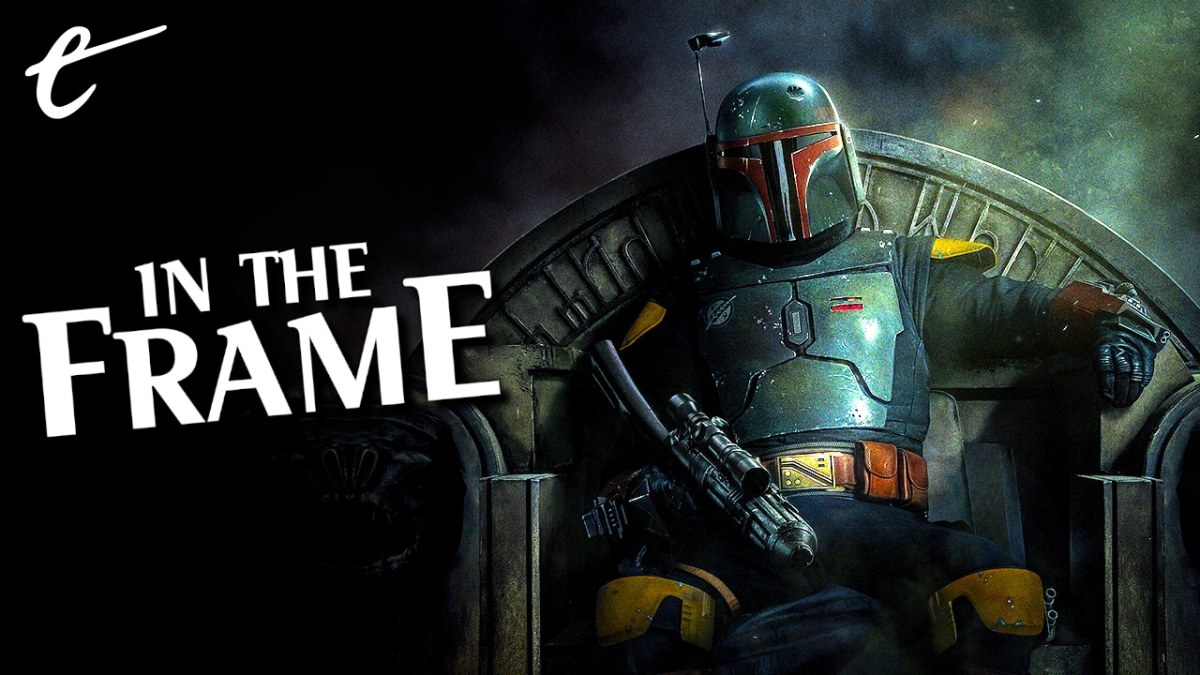Boba Fett looks cool.
One of the most enduring and appealing aspects of the original Star Wars was the extent to which it created a world that seemed much deeper than the simple story being told. When Han Solo (Harrison Ford) boasts about how the Millennium Falcon “made the Kessel Run in less than twelve parsecs,” it suggests an entire unseen adventure. When Luke Skywalker (Mark Hamill) and Obi-Wan Kenobi (Alec Guinness) arrive in Mos Eisley, every alien there looks like they have their own story.
One of the great features of the Star Wars universe was the way in which everything within the film felt both designed and lived in, as if every corner of the frame could sustain the audience’s focus. Boba Fett is a great example of this. Boba Fett is a bounty hunter with a jetpack, a man of few words who wears distinctive armor. Just looking at Fett, it is easy to imagine that the character has lived a life outside of what is shown on screen — even if the details of that life are best left shrouded in ambiguity for fans to explore themselves.
Part of what is interesting about Boba Fett is the extent to which the design is the character. According to George Lucas, Boba Fett is based upon an early and abandoned concept for Darth Vader. According to Joe Johnson, the design was then developed as something much more generic, as the model for “an army of super troopers.” There wasn’t ever any real sense of who Boba Fett was underneath that design. There was no real context or identity for the visual.
According to Josef Benson, Boba Fett was created at least in part to satisfy Kenner Toys, which wanted a new action figure that it could release before the sequel to Star Wars arrived in cinemas. Kenner had been unable to keep up with demand for toys during the original Star Wars, having to literally sell empty boxes and receipts for Christmas 1977, so it was eager to capitalize on the Star Wars license.

This desire to generate a market for Star Wars action figures was a driving factor behind The Star Wars Holiday Special, broadcast on CBS in November 1978. Fett made his first on-screen appearance in an animated segment of The Star Wars Holiday Special, voiced by Don Francks. However, Fett’s actual first appearance was even further divorced from any larger franchise narrative. Duwayne Dunham donned the costume to take part in the San Anselmo Country Fair in September 1978.
Boba Fett didn’t really exist as a character, but instead as a collection of iconography. When the character finally appeared in cinemas for The Empire Strikes Back, played by Jeremy Bulloch, he played a small but crucial role. Bulloch remarked that his performance was deliberately minimalist, acknowledging, “The less you do with Boba Fett, the stronger he becomes.” During the betrayal at Bespin, Fett’s stillness contrasts nicely with Darth Vader’s theatricality.
Fett’s smartest move in The Empire Strikes Back is passive. When Vader hires a diverse group of bounty hunters to track down the Millennium Falcon, Fett’s competitors all fly away to the far corners of the galaxy to begin their search. In contrast, Fett hangs back on the Star Destroyer long enough to spot the Millennium Falcon hiding on the hull. Fett works smarter, not harder. As Bulloch pointed out, Fett does less and accomplishes more.
Fett reappears in Return of the Jedi, mingling at Jabba the Hutt’s palace. He seems relaxed. At one point, he appears to be flirting with entertainers Rystáll (Mercedes Ngoh) and Lyn Me (Dalyn Chew). Once again, Fett is most effective doing nothing; he is part of the group that lurks around Jabba’s throne room to catch Leia (Carrie Fisher) when she attempts to free Han from captivity. However, Fett immediately runs into trouble when he is actually called upon to do something.

After capturing Leia and Luke, Jabba takes his pleasure barge out into the deserts of Tatooine. He plans to feed Han and Luke to the dreaded Sarlacc. Naturally, Luke masterminds an escape. During that escape, Boba Fett gets his only real action scene in the entire original trilogy. He attempts to draw a gun on Luke at point-blank range, allowing the Jedi to simply cut through the blaster with a lightsaber. Then a vision-impaired Han accidentally activates Fett’s jetpack.
In one of the most delightful sequences in the entire Star Wars saga, Fett is flung through the air like he is strapped to a rocket in a Looney Tunes cartoon. The framing is wonderful, with Fett even hurtling through the background as Luke takes on a bunch of guards on another floating vessel. Fett screams, crashes into the side of Jabba the Hutt’s pleasure barge, rolls down the sand, and gets swallowed by the Sarlacc. The Sarlacc then burps, to underscore the absurdity of the moment.
It’s a brilliant moment in an otherwise flawed movie, in large part because it’s built around the understanding that Fett is a character who was primarily designed to look cool. He is an action figure. Indeed, Bulloch was handed his own action figure before he even began filming The Empire Strikes Back. Once Fett is actually asked to do anything more than pose menacingly, it all falls apart. One Lucasfilm insider reported the sequence was “typical of [Lucas’] dark sense of humor.”
Perhaps Lucas was consciously playing with the fandom’s fixation on Boba Fett. Almost two decades later, the prequel Attack of the Clones introduces a younger version of Boba Fett (Daniel Logan). Boba is revealed to be a clone of his bounty hunter father Jango Fett (Temuera Morrison). Jango is also revealed to be the genetic template for the mass-produced clone troopers, the predecessors of the stormtroopers, possibly the worst army in science fiction. There is nothing unique about Boba.

More to the point, Lucas doubles down on the grim punchline from Return of the Jedi. Having spent a significant stretch of Attack of the Clones promising to pay off decades of expectations involving Jango Fett, the character is thrown into the fray during the Battle of Geonosis. However, just like Boba, it is revealed Jango isn’t really all that. The character dies quite early in the movie’s extended climax, trampled by a beast and then handily beheaded by Mace Windu (Samuel L. Jackson).
There’s something very clever and very pointed in all of this, in the understanding that Boba Fett is a triumph of design rather than narrative, and that his legacy endures as a mass-produced action figure rather than as a dramatic character. The treatment of Boba and Jango Fett is one of the more self-aware aspects of George Lucas’ Star Wars, an illustration of the writer and director’s unique sense of humor and his understanding of the context in which these films exist.
On some level, Star Wars fans intrinsically understand this. While many of Lucas’ revisions to the original Star Wars trilogy were controversial, nobody reacted too strongly to Lucas’s decision to dub Morrison’s voice over the previously uncredited voice actor Jason Wingreen on subsequent re-releases of The Empire Strikes Back. Indeed, the starting premise of The Mandalorian is rooted in the understanding that Boba Fett looks cool, and that iconography can be ported to a new character.
This is part of what makes the fandom’s fixation on Boba Fett so interesting. Fett was — and remains — a breakout character in a franchise full of breakout characters. Fans were outraged by the character’s death in Return of the Jedi. The expanded universe revealed Boba Fett survived being swallowed by the Sarlacc and went on to have a series of badass bounty hunter adventures. Fan film The Dune Sea imagined Fett’s escape from the literal belly of the beast. The expanded universe also tempered other aspects of Fett’s portrayal, reframing his relationship with Lyn Me as paternal and professional.

Inevitably, the Star Wars canon has moved towards this fan fantasy of Boba Fett as a hypercompetent badass. Daniel Logan reprised his role as the young Boba Fett in the animated series The Clone Wars, which offered a much more impressive take on the iconic bounty hunter. The production team had even planned further arcs for the character. In 2014, after Disney had bought Star Wars from Lucas, Jonathan Rinzler stated that Lucas himself believed that Boba Fett was alive.
Temuera Morrison reprised his role for the second season of The Mandalorian, confirming in continuity that Fett survived the Sarlacc pit. Morrison is getting his own spin-off, The Book of Boba Fett, which looks to be a Star Wars riff on The Godfather. Fett’s legacy was tidied up in other ways, with The Bad Batch drawing a clear line between the mostly capable clone troopers based on Fett’s genetic code and the largely incompetent stormtroopers from the original Star Wars trilogy.
The past decade or so has transformed Boba Fett into the badass bounty hunter that he looked like all along. These days, Fett is cool, commanding, and competent. This portrayal lines up neatly with what fans expected based on that classic action figure. Some fans are undoubtedly happy with that, and that’s great. However, much like the portrayal of Darth Vader at the end of Rogue One, it also smooths over one of the most compelling contradictions in the Star Wars canon in favor of easy fan service.
Boba Fett remains one of the best designs within the larger Star Wars franchise. However, what really made the character special was the deliberate dissonance between the coolness that the character projected and his actual ability. Boba Fett was a cool action figure, and it’s okay to play with that.






Published: Nov 5, 2021 11:00 am